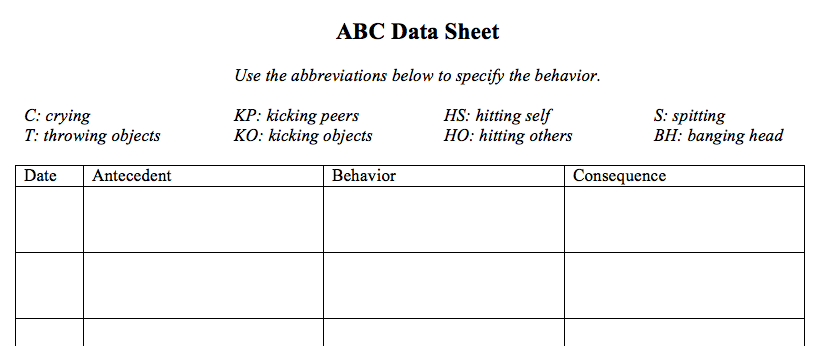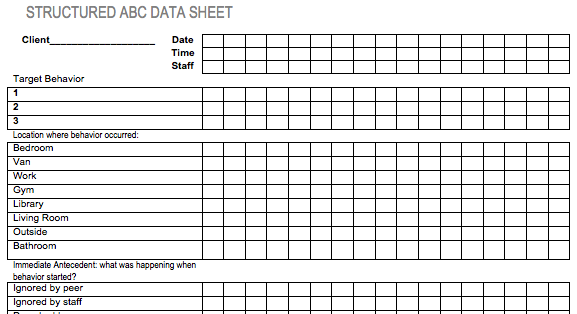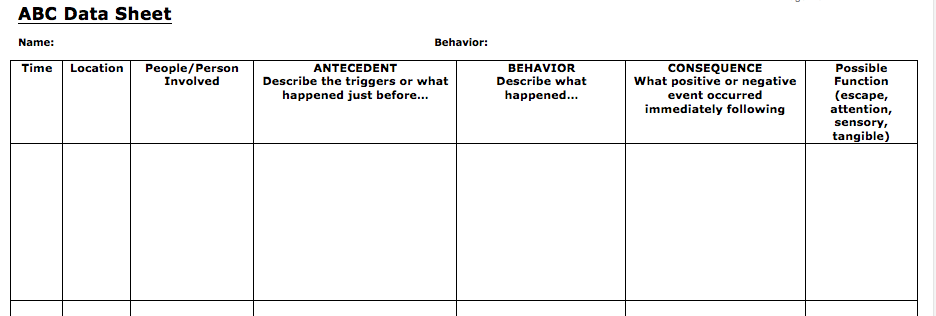ABC Data
A-B-C data references the three-term contingency: antecedent, behavior, and consequence. These data provide information on what occurs just before, during, and just following the target behavior.
Tyler’s Screaming
Tyler’s teacher called on him during circle time to answer a question. Tyler began screaming and the teacher ignored the screaming and moved on the next student.
Antecedent: Tyler was asked a question during circle time
Behavior: screaming
Consequence: Teacher ignored the screaming, Tyler was no longer required to answer the question
The ABC data on the occurrence of Tyler’s screaming above describes the behavior in context. From these data, the reinforcement contingency may become apparent. If more accounts like this are collected on Tyler’s screaming behavior, it will seem as though the screaming is maintained by a negative reinforcement contingency (escape from demands).
Melody’s Kicking Peers
During group instructional time, Melody kicked the student in front of her. The student turned around and yelled at Melody and the teacher came over and verbally reprimanded Melody.
Antecedent: During group instruction
Behavior: Kicked student in front of her
Consequence: Student turned around and yelled at Melody, teacher came over and delivered a verbal reprimand
The ABC account of Melody’s kicking peers behavior indicates that the Melody received a response from both the student and the teacher. The antecedent, group instructional time, indicates that Melody was not receiving one-on-one attention and may have been in a state of deprivation, making attention a more powerful reinforcer. If more accounts like this are collected on Melody’s kicking peers behavior, it will seem as though the kicking is maintained by a positive reinforcement contingency (delivery of attention).
Recording ABC Data
Depending on the behavior analyst conducting the assessment, the ABC data sheet may be modified in different ways. There may simply be a space to describe the antecedents, behaviors and consequences, or check boxes may be used. Below are a few examples of how an ABC data sheet may be constructed.
Open-Ended ABC Data Sheet: This data sheet provides space for inputting the data. It is up to the observer to include all the relevant information. An advantage of this type of data sheet is that in allows for inclusion of specific details and a limitation is that the RBT recording the data may forget to include a specific detail.

Structured ABC Data Sheet: This data sheet using check boxes and is arranged in a vertical fashion. The possible setting and consequences are listed in tables and the RBT completed a column of check boxes for each occurrence.

ABC Data Sheet with Additional Columns: This data sheet provides additional prompts to ensure that all the important data are collected. It also includes a space for recording the client’s response to the consequence that was issued. For instance, in the example above, how did Melody react to the verbal reprimand she received from the teacher?

ABC Data Sheet with Prompts: This data sheet is a version of the open-ended data sheet above but it also provides prompts for the person completing it. This provides additional guidance for the RBT who is recording the data.

